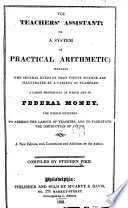 | James L. Connolly (mathematician.) - Arithmetic - 1829 - 266 pages
...The first term, the last term, and the number of terms, given to find the common difference. HULK. Divide the difference of the extremes by the 'number of terms less one, and the quotient will be the com1 mon difference, or fourth term. Or, from the second term subtract... | |
 | William Kinne - 1829 - 246 pages
...yard. PROBLEM 11. The extremes and the number of terms being given, to find the common difference. • RULE. — Divide the difference of the extremes by the number of terms loss 1, and the quotient will be the common difference. EXAMPLES. 1. The extremes are 3 and 19, and... | |
 | Thomas Tucker Smiley - 1830 - 188 pages
...terms. Case 2. When the first and last terms (or two extremes,) are given to find the common difference. Rule. Divide the difference of the extremes by the number of terms, less 1 ; the quotient will be the common .difference. Questions. What is Arithmetical Progression? Name... | |
 | Roswell Chamberlain Smith - Arithmetic - 1830 - 286 pages
...fAcn¡25-r- 5 =-5 years, the common difference. A.5угs. Hence, to find the common difference ; — Divide the difference of the extremes by the number of terms, less 1, and the quotient will be the common difference. 2. If the extremes be 3 and 23, and the number of... | |
 | Daniel Adams - Arithmetic - 1830 - 294 pages
...difference. Hence, when the extremes and number of terms are ffiven, to find the common difference, — Divide the difference of the extremes by the number of terms, less 1, and the quotient will be the common difference. 6. If the extremes be 5 and 605, and the number... | |
 | Arithmetic - 1831 - 198 pages
...were afterwards sold at 12 for a farthing? Ans. 86L. 17s. lOd. CASE 2. ARITHMETICAL PROGRESSION. 173 RULE. Divide the difference of the extremes by the number of terms, less one; the quotient will be the common difference. EXAMPLES. 1 . Twenty and sixty are the two extremes of a certain series in arithmetical... | |
 | Ira Wanzer - Arithmetic - 1831 - 408 pages
...answer. PROBLEM III. — The extremes and the number of terms being given, to find the common difference. RULE. — Divide the difference of the extremes by the number of terms less 1, and the quotient will be the common difference. EXAMPLE 1. If the extremes be 4 and 18, and the... | |
 | Daniel Adams - Arithmetic - 1831 - 276 pages
...difference. Hence, when the extremes and number of terms are given, to find the common difference, — Divide the difference of the extremes by the number of terms, less 1, and the quotient will be the common difference. 6. If the extremes be 5 and 605, and the number... | |
 | Arithmetic - 1831 - 210 pages
...did the linen produce, when the pins were afterwards sold at 12 for a farthing? Ans. 86L. 17s. 10d. CASE 2. When the two extremes and number of terms are given, to find the common difference. RULE. Divide the difference of the extremes by the number of terms,... | |
 | Daniel Adams - Arithmetic - 1831 - 276 pages
...difference. Hence, when the extremes and number of terms are given, to find the common difference, — Divide the difference of the extremes by the number of terms, less 1, and the quotient will be the common difference. 6. If the extremes be 5 and 605, and the number... | |
| |